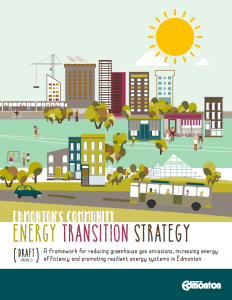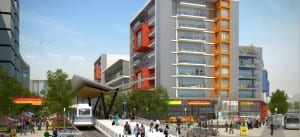Efficiency and opportunity – Edmonton’s Community Energy Transition Strategy
Climate change and energy security are topics that garner a significant amount of attention, but they are issues that have become clouded with noise. To see the real gravity of the these issues, however, we don’t have to look much further than the disastrous Calgary floods of 2013, the increasingly intense summer storms we now face, or the growing legions of potholes caused by Edmonton’s more frequent freeze and thaw cycles. Like it or not, the problem is at our doorstep.
But what can the City actually do to help mitigate these issues? Turns out, quite a bit.
 Tomorrow, Edmonton’s City Council will be discussing the Edmonton Community Energy Transition Strategy. It’s an ambitious but achievable plan that understands our current need for fossil fuels, but begins to create pathways for us to start reducing our dependence on carbon. With 95% of our City’s energy coming from fossil fuels, we’re exposed to a number of risks, including longer-term high energy prices, increases in global temperatures and recurring air quality warnings. The Energy Transition Strategy begins to help us address those risks, which is what smart cities begin to do when faced with clear and present warning signs.
Tomorrow, Edmonton’s City Council will be discussing the Edmonton Community Energy Transition Strategy. It’s an ambitious but achievable plan that understands our current need for fossil fuels, but begins to create pathways for us to start reducing our dependence on carbon. With 95% of our City’s energy coming from fossil fuels, we’re exposed to a number of risks, including longer-term high energy prices, increases in global temperatures and recurring air quality warnings. The Energy Transition Strategy begins to help us address those risks, which is what smart cities begin to do when faced with clear and present warning signs.
While a core function of the Transition Strategy is certainly about meeting risk head on, it’s also about highlighting the key leadership role the City must take to drive change. To meet its target of a 25% reduction in energy use per person by 2035, and a reduction in GHG emissions by 35%, the City will have to look inward and improve the energy efficiency of our own buildings, find opportunities to advance combined heat and power technologies in our operations and promote energy conservation and efficiency in the vehicles we use. In tandem with our efforts to ‘mode shift’ residents to more active, non-automobile based transportation, we’ll encourage others to find efficiencies in their own commercial, residential and industrial buildings, advance the use of electric vehicles and look at generating 10% of the energy we require from within Edmonton’s boundaries.
These targets will not be achieved through a single action, but through many different actions working concurrently; and yes, these actions come with a price tag. The good news is that our investments will be staggered, and the returns far exceed the costs.
 The first several years of the Community Energy Transition Strategy are focused on education and outreach to the public, which means much of the required finances will be accessed through existing budgets and additional funds will not be needed. By approximately 2018, more substantial investments, in the range of $10 million per year from the City, will be required to implement some of the larger community-scale projects. Edmonton is not in this alone, and we will seek to partner with other orders of government for these required investments, along with other municipalities across the province in cases where partnership is possible.
The first several years of the Community Energy Transition Strategy are focused on education and outreach to the public, which means much of the required finances will be accessed through existing budgets and additional funds will not be needed. By approximately 2018, more substantial investments, in the range of $10 million per year from the City, will be required to implement some of the larger community-scale projects. Edmonton is not in this alone, and we will seek to partner with other orders of government for these required investments, along with other municipalities across the province in cases where partnership is possible.
By implementing small and community scale programs, the impact to citizens’ everyday lives will begin to be noticeable almost immediately through more efficient energy use, less reliance on vehicles and greater return on our infrastructure investments. If the participation of Edmontonians matches the modeling done by City administration, we could see collective savings of approximately $2.5 billion by 2035. When the social cost of GHG reductions are considered, these savings increase to $3.5 billion. This doesn’t even begin to account for the diversification benefits that Edmonton’s labour market could see with an increase in renewable energy-related jobs.
This Strategy finds its roots in The Way We Green and was developed through three phases, and included feedback from Edmonton’s Renewable Energy Task Force, modeling from independent experts and a review from stakeholders including provincial government departments, utility companies and industry associations. As we move into the tactical phase, the consultation with these groups will continue.
At first blush, tackling these massive issues might seem insurmountable, but we only have to look at our recent past for good lessons on how to reimagine our future. Back in the 80s we saw a crisis coming with dwindling landfill space and we built a plan that has now positioned Edmonton as a world leader in waste management. We’ve never been one to shy away from bold challenges and see the opportunity for what it is.
Edmonton’s Community Energy Transition Strategy brings us both in equal measure.
I just returned from Europe where very stringent energy standards are being demanded for all new buildings and also for retrofitting of buildings. They are requiring that all construction conform to Passive House Standards. Heating energy shall be less than 15 kWh/m2 and the building shall have a blower door test that is less than 0.5ACH50. This would reduce heating by about 80 to 90% and make spaces much more comfortable. This is not new technology we did it in the 1970’s, is being done in Europe but we have ignored it in North America except for a few examples.
broken link above in para. 3 – I guessed and this one works: http://www.edmonton.ca/city_government/documents/EnergyTransitionStrategy.pdf
Thanks, Andy! I think it’s repaired.